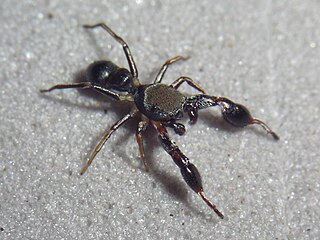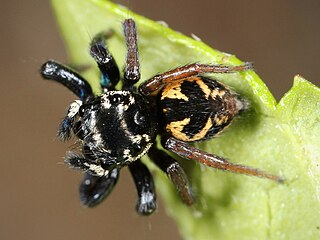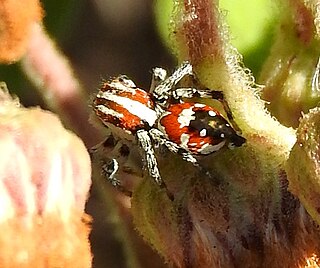
Bagheera is a genus of jumping spiders within the family Salticidae, subfamily Salticinae and subtribe Dendryphantina. The genus was first described by George Peckham & Elizabeth Peckham in 1896. The name is derived from Bagheera, a character from Rudyard Kipling's Jungle Book.

Bellota is a genus of jumping spiders that was first described by George Peckham & Elizabeth Peckham in 1892. It is similar in appearance to the genus Chirothecia, but has a narrower cephalothorax and a shorter eye area.

Breda is a genus of jumping spiders that was first described by George Peckham & Elizabeth Peckham in 1894.

Chira is a genus of jumping spiders that was first described by George Peckham & Elizabeth Peckham in 1896. It is currently named after Rio Chira, a river in Peru, but the Peckhams originally called the genus Shira, later emended by Eugène Simon.

Corythalia is a genus of jumping spiders that was first described by Carl Ludwig Koch in 1850.

Cotinusa is a genus of jumping spiders that was first described by Eugène Louis Simon in 1900.
Eustiromastix is a genus of jumping spiders that was first described by Eugène Louis Simon in 1902.
Fluda is a genus of jumping spiders that was first described by George and Elizabeth Peckham in 1892.

Jollas is a genus of jumping spiders (Salticidae), found in Central America, the Caribbean and South America.

Lyssomanes is a spider genus of the family Salticidae, ranging from South and Central America, up to the southern United States.

Menemerus is a genus of jumping spiders that was first described by Eugène Louis Simon in 1868. They are 4 to 10 millimetres long, flattened in shape, and very hairy, usually with brown and grayish hairs. Most species have white edges on the thorax. The abdomen is often oval, or sometimes elongated or rounded.

Messua is a spider genus of the family Salticidae.
Nagaina is a genus of jumping spiders that was first described by George and Elizabeth Peckham in 1896. The name is derived from Nagaina, a character from Rudyard Kipling's Rikki-Tikki-Tavi. Other salticid genera with names of Kipling's characters include Bagheera, Messua, and Akela.

Nycerella is a genus of spiders of the jumping spider family, Salticidae.

Pachomius is a genus of jumping spiders that was first described by George and Elizabeth Peckham in 1896. Uspachia was merged into genus Romitia in 2007, and all nine species were merged into Pachomius in 2015. The name is derived from Pachomius, the founder of cenobitic monasticism.

Synemosyna is a genus of ant mimicking jumping spiders that was first described by Nicholas Marcellus Hentz in 1846.

Zuniga is a genus of ant mimicking jumping spiders that was first described by George and Elizabeth Peckham in 1892. As of September 2019 it contains two species, found in South America, Costa Rica, and Mexico: Z. laeta and Z. magna. It is a senior synonym of Arindas and Simprulloides.

Zygoballus is a genus of jumping spiders found in North and South America.

Bagheera kiplingi is a species of jumping spider found in Central America, including Mexico, Costa Rica, and Guatemala. It is the type species of the genus Bagheera, which includes three other species, including B. prosper. B. kiplingi is notable for its peculiar diet, which is mostly herbivorous. No other known species of omnivorous spider has such a markedly herbivorous diet.















